As if it hasn’t been hot enough this muggy August, why not add a little fire to the heat! UF/IFAS partnered with Barry Coulliette (Alachua Conservation Trust) and Chuck Cowart (Double C Ranch) to conduct a controlled summer burn on 40 acres of native timberland on Friday, August 13, 2021 – listen to the cracklin’ fire on the youtube video — https://www.youtube.com/watch?v=QfT7COi0RYs. Summer burns are challenging since all the stars must align, but we managed to have a descent streak of good conditions to pull it off. The first question that most folks ask is why in the world would you start a fire in the forest when the temperatures are scorching in the 90’s on a daily basis. Prior to human interference, the summer was considered lightning season burning where natural burning occurred seasonally and typically improved ecological conditions. In this particular situation, our goal was to burn native timberland that is managed for cattle grazing purposes to promote the resurgence of nutritional grasses that are palatable for the local beef herd. Wiregrass, in particular, is not very tasty nor digestible once it matures, but it’s palatability and nutritional benefits (particularly crude protein and digestability) increase when it is in young and tender during the regrowth phase following the summer burn. Summer burns are extremely beneficial for cattle grazing lands since the prominent seeds that germinate in the summer are more forage related and improve ground cover.
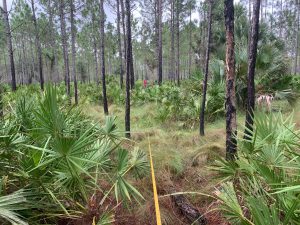
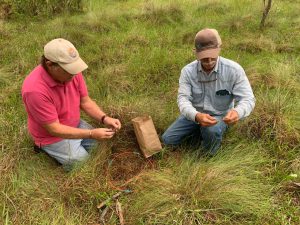
George Johnson (NRCS), Wendy Mussoline (UF/IFAS) and property owner Chuck Cowart conducted a preliminary plant inventory using a 100-foot line intersection grid system to classify every plant within six different subplots. Samples of the mature wiregrass were also collected prior to the burn for comparison purposes. Upon completion of the burn, the plan is to monitor the regrowth of vegetative matter and its respective nutritional components during the regrowth stage to document the impacts of the intervention. After monitoring rain, soil moisture, wind speeds, temperature highs and relative humidity for nearly two months, we finally established a very short window that would help us to achieve our goals. Friday the 13th it would be!
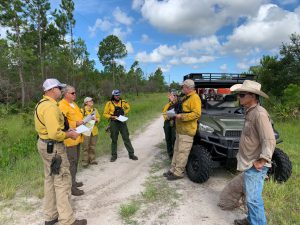
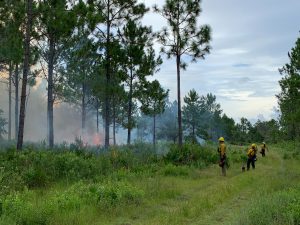
Barry Coulliette generated a prescribed burning plan, obtained a burn authorization number, and led the boots on the ground with clear direction. Summer burns are fickle since there is a delicate dance in burning brush that is not too dry and not too wet – it has to be just right. Toward the beginning of the summer, the timber was too dry and the risks of wildfire were too high. We had to wait for enough rainfall to saturate the ground, and then wait for the rain to stop for a few days in order to successfully ignite the fine fuel moisture consisting of pine straw, palmetto, wiregrass, and dead plant material. Winds were fairly mild in the morning at 6 MPH originating in the northeast with a slight shift to easterly/southeasterly winds in the afternoon. In Flagler County, we are close to the ocean so the easterly seabreeze was beneficial to ensure that the wind was not going to switch direction in the middle of the burn. However, the challenge with a seabreeze is that it increases relative humidity which suppresses burning conditions. Our relative humidity was 61% which requires the use of more starter fuel, whereas ideal conditions would have been a bit lower between 40 and 50%. Of course, the summer thunderstorms that often arise in a moment’s notice also create a challenge so we had to keep a very close watch on the real-time radar. Barry’s leadership, extensive experience in variable burning conditions, and overwhelming focus on safety was appreciated and contributed to a successful summer burn and hopefully the cows will appreciate some fresh forages in the next few months.
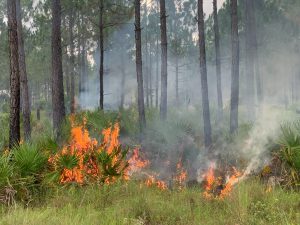

 0
0
